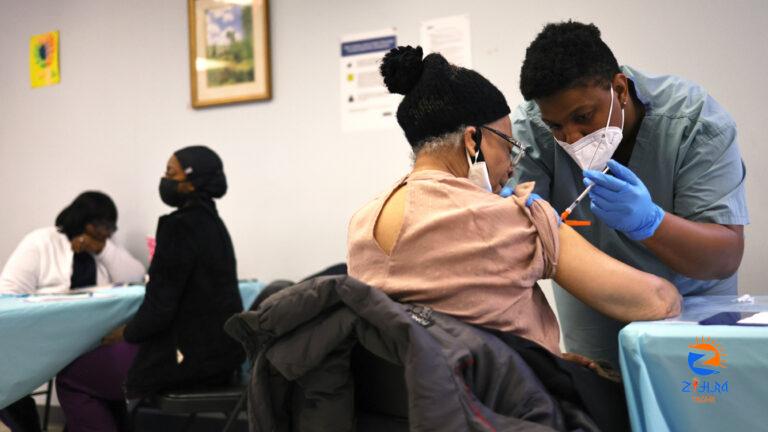
[ad_1]
As the Delta variant of the coronavirus has spiked in areas of the country with low vaccination rates, the staff at Missouri’s Mercy Hospital Springfield has struggled to keep pace.
“Our physicians on the floors are pretty tired. They’re working almost daily, some of them for weeks on end, same with all of our other care provider teams,” Erik Frederick, the hospital’s chief administrative officer, told Yahoo News, adding, “This surge, we know it’s being driven by that lack of [vaccine] acceptance. There’s a layer of frustration there as well, because this could be prevented, and although it’s not a large number, every single patient that dies is a tragedy because it was preventable.”
The Springfield-Greene County Health Department has reported more than 1,500 new COVID-19 cases since the start of July, including an average of 191 new cases over the last seven days.
As of July 13, Mercy Hospital Springfield was treating 130 COVID-19 patients. Of those, 34 were in the intensive care unit and 30 were on a ventilator. To accommodate the surge of patients, the hospital added a sixth COVID-19 unit over the weekend. Only five were needed last year during the first surge of coronavirus cases in the area.
Frederick noted that the demographics of the recent surge are different from the last.
“What we’re seeing here in the hospital is a much larger population of patients that range from mid-30s to the late 50s,” Frederick said. “They’re younger and sicker for sure,” he added.
Most of the patients who are currently hospitalized, and those who are the sickest, according to Frederick, are unvaccinated. “We really have seen less than 4 percent of the patients who are hospitalized that are fully vaccinated, and we have not had any vaccinated patients in the ICU level of care yet,” he said.
According to health officials, 39 percent of the Springfield-Greene County population has been fully vaccinated. That’s well below the national average of 48 percent and a far cry from the 70 percent mark that experts believe could provide herd immunity to people unable to receive the vaccine due to underlying health conditions.
Due to uneven vaccination rates and the emergence of new strains of the virus, the pandemic has come in waves that have crashed in different parts of the country at different times. Health experts say the recent uptick in cases is primarily due to localized outbreaks in areas of the country with low vaccination rates. Currently, parts of Arkansas, Missouri, Texas and Nevada are struggling as the Delta variant spreads.
“If you’re in an area where the vaccination rates are high, it is more likely that you will not have any of these deaths and hospitalizations,” said Yahoo News Medical Contributor Dr. Kavita Patel. “But if you are in an area that has a high degree of unvaccinated people compared to vaccinated, it’s a different America for you because not only do we have a more infectious variant, but we have [more] people for that variant to infect.”
Last spring, as the coronavirus began spreading quickly across New York City, NYC Health + Hospitals, the largest public health care system in the U.S., was at the epicenter of the nation’s battle against COVID-19.
One hospital in particular, Elmhurst Hospital Center in Queens, was hit hard. During the last week of February and the first week of March 2020, the 545-bed hospital, which serves one of the most ethnically diverse communities in the country, had a patient roster that was over 230 percent capacity.
Dr. Laura Iavicoli, senior assistant vice president of emergency management at NYC Health + Hospitals, told Yahoo News that the system of 11 hospitals, of which Elmhurst is part, had never faced anything like the coronavirus pandemic before.
“Overnight, there was a light switch that turned on and we went from, you know, just generally speaking four cases to 4,000 cases in a matter of days,” said Iavicoli. “There were a lot of emotions. There was the fear of the unknown. We really didn’t know what we were exactly dealing with, how to treat it, how to keep ourselves safe. I mean, we were doing everything we knew from what we were hearing in other countries, and applying it here, but there were a lot of questions,” she added.
By the end of last year’s surge, NYC Health + Hospitals had treated over 25,000 COVID-19 patients, pushing its staff to the limits. This year, however, is a markedly different story. As of July 14, the city’s seven-day daily average for hospitalizations stood at 18.
Iavicoli says the system has seen a “180-degree change in the hospitalization rate of COVID cases,” going from “completely all COVID hospitals to now having only a few dozen COVID patients” in its facilities.
She told Yahoo News that the drop in hospitalizations “is really pretty much solely due to the vaccination efforts that have happened in New York City.”
According to the New York City Health Department, 64 percent of the city’s adult population has been fully vaccinated. In Queens, one of the hardest-hit boroughs and where Elmhurst Hospital Center is located, 70 percent of all adults have been fully vaccinated for COVID-19. New York City’s positivity rate has also remained low since May of this year, giving health care workers in all city hospitals a much needed break.
For Patel, the takeaway when comparing what is happening now in hospitals in Missouri and New York is clear: Get vaccinated. That’s especially true given the fact that the Delta variant is more transmissible than the original strain of the coronavirus.
“As the variants get more infectious, the amount of people that we need to vaccinate just increases,” she said. “We just need to keep setting the bar higher, not lower, when we have a more infectious variant.”
____
Read more from Yahoo News:
[ad_2]